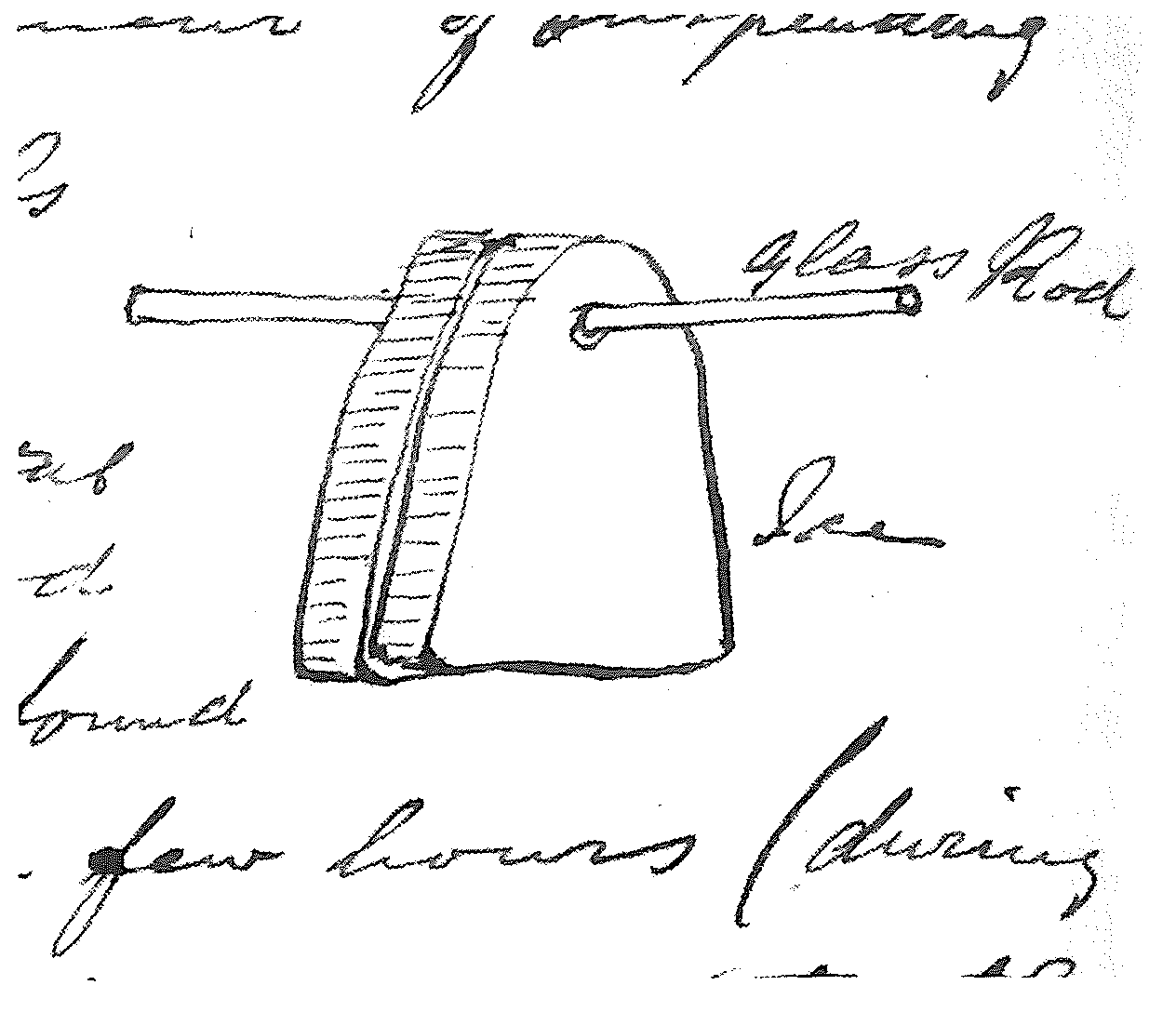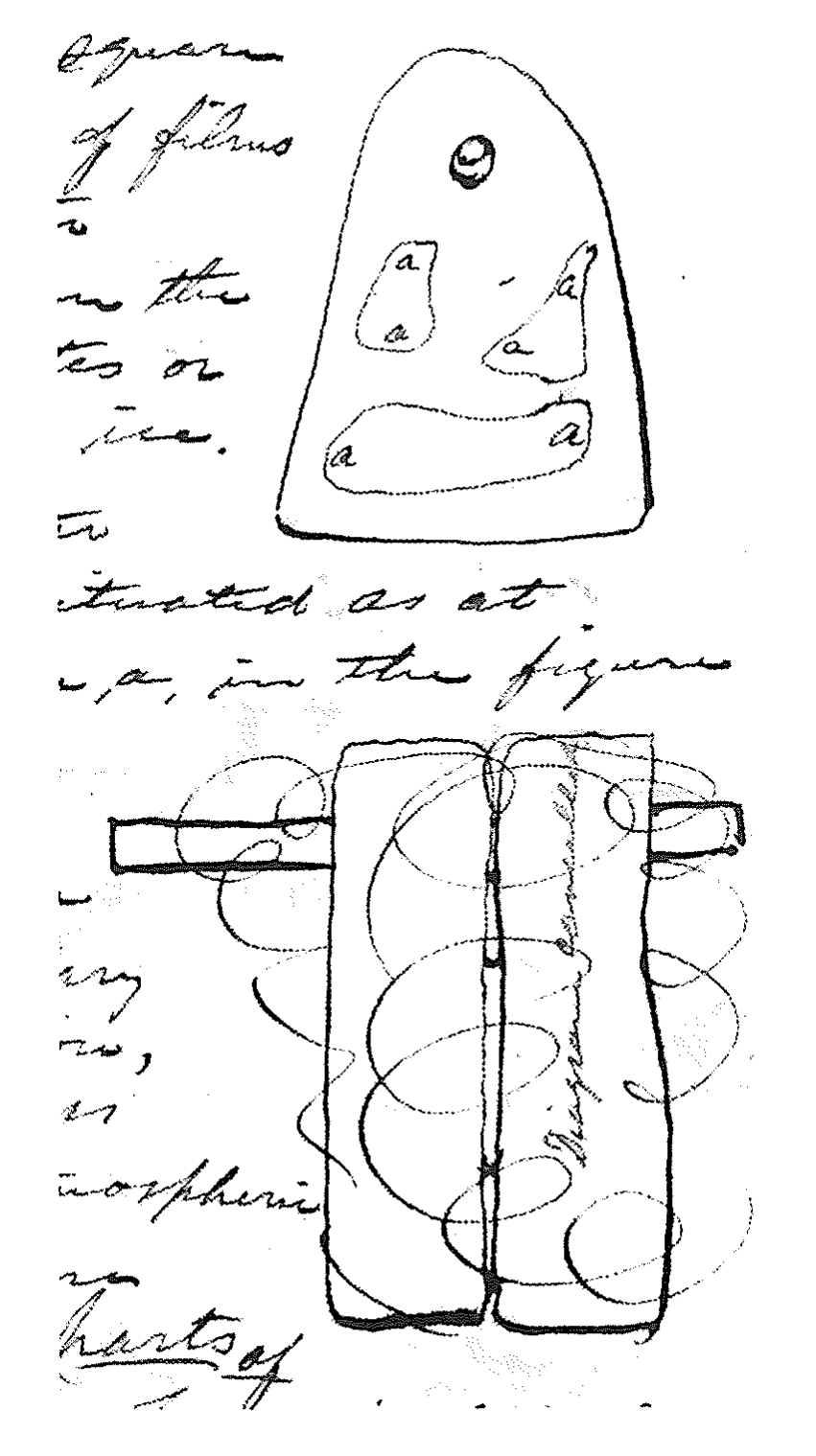James Thomson to Faraday 24 November 1858
2 Donegall Square, West, Belfast, | 24th Nov. 1858.
My dear Sir,
I am much obliged for your letter of the 15th inst.1 and I presume I have to thank you and Prof Tyndall jointly for a copy of his paper2 containing the note from you appended3, which he has kindly sent to me and of which the contents interest me much.
There was hard frost here last night:- and having happened to meet with slabs of ice about 1½ ins thick, I have repeated Forbe[s]’s experiment of suspending two slabs of ice on a horizontal glass rod thus
 I found that in a few hours (during which water was constantly dropping from them) the two slabs were stuck fast together: and I did not find it necessary to apply springs to produce any pressure at all. I merely pressed them gently with my hands for a few seconds a first to make them keep close to-gether by an incipient cohesion or a cohesion of some minute spots. The cohesion then went on increasing till in a few hours it became very strong. Although there is no spring necessary, yet the capillary attraction due to the films of water between the two plates alluded to in my last letter to you4 must keep up a steady force drawing the plates together, and causing pressure at some parts. I could see many square inches of films of water between the two plates or slabs of ice. This water being situated as at a, a, a, a, a,
I found that in a few hours (during which water was constantly dropping from them) the two slabs were stuck fast together: and I did not find it necessary to apply springs to produce any pressure at all. I merely pressed them gently with my hands for a few seconds a first to make them keep close to-gether by an incipient cohesion or a cohesion of some minute spots. The cohesion then went on increasing till in a few hours it became very strong. Although there is no spring necessary, yet the capillary attraction due to the films of water between the two plates alluded to in my last letter to you4 must keep up a steady force drawing the plates together, and causing pressure at some parts. I could see many square inches of films of water between the two plates or slabs of ice. This water being situated as at a, a, a, a, a,
 in the figure must exist, by virtue of capillary attraction, under less than atmospheric pressure at all parts of itself. This diminished pressure must tend to cause the water to freeze even at a temperature slightly above the ordinary freezing point. The diminished pressure in the liquid film, extending over several square inches, will cause the external atmospheric pressure to force the two slabs against one another with quite a notable force.
in the figure must exist, by virtue of capillary attraction, under less than atmospheric pressure at all parts of itself. This diminished pressure must tend to cause the water to freeze even at a temperature slightly above the ordinary freezing point. The diminished pressure in the liquid film, extending over several square inches, will cause the external atmospheric pressure to force the two slabs against one another with quite a notable force.
It seems to me that you have somewhat misconceived my meaning in respect to a “difficulty of making a beginning” as you say in your last letter:-
“I will mention a difficulty as regards the beginning of regelation which occurs to me under your view if the particles be supposed to be without this external relation. You admit with me that bodies tend to retain that state which they for the time possess; and, that against a change of temperature of many degrees of heat;- then how can the small change of temperature not amounting to the 1/100th of a degree, due to difference of pressure in many of the regelation experiments, cause that change from solid to fluid, or fluid to solid, which many degrees of temperature change applied in the common way will not effect?”
With reference to this I would say, that, I think the resistance to change of state, from liquid to solid or solid to liquid; or liquid to gaseous, or gaseous to liquid, under consideration occurs only when the substance is not present in the two states already (as for instance when water is cooled below 32˚F. without freezing, there is no ice present) but when both water and ice are in contact, as is the case in the regelation experiments it is a part of my theory to suppose that there is no tendency for water, to remain water, or ice to remain ice, against any change of temperature however slight tending to change the state of the water or the ice.
I shall look with much interest to the ideas given in your note annexed to Prof. Tyndall’s paper, and to the suggestion you give in your last letter to me of a “fourth theory of regelation” as being perhaps possible to be built up.
I am My dear Sir, | Very truly yours | James Thomson.
Prof. Faraday
Bibliography
TYNDALL, John (1858): “On some Physical Properties of Ice”, Phil. Trans., 148: 211-29.
Please cite as “Faraday3530,” in Ɛpsilon: The Michael Faraday Collection accessed on 28 April 2024, https://epsilon.ac.uk/view/faraday/letters/Faraday3530